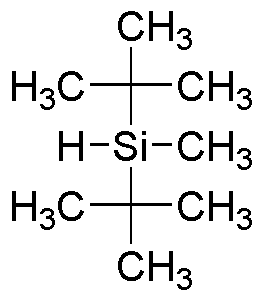Di-tert-Butylmethylsilane is widely utilized in research focused on:
- Organic Synthesis: This compound serves as a protecting group for alcohols and amines, allowing chemists to selectively modify other parts of a molecule without affecting the protected site.
- Silicon-Based Materials: It is used in the production of silicon-containing polymers, which are important in industries like electronics and coatings due to their thermal stability and flexibility.
- Pharmaceutical Development: In drug formulation, it helps in enhancing the solubility and bioavailability of active pharmaceutical ingredients, leading to more effective medications.
- Surface Modification: This chemical is employed to modify surfaces of materials, improving their hydrophobicity and chemical resistance, which is crucial in applications like biomedical devices and sensors.
- Research in Catalysis: It acts as a ligand in catalytic processes, facilitating various chemical reactions and improving efficiency, which is vital for sustainable chemical manufacturing.
General Information
Properties
Safety and Regulations
Applications
Di-tert-Butylmethylsilane is widely utilized in research focused on:
- Organic Synthesis: This compound serves as a protecting group for alcohols and amines, allowing chemists to selectively modify other parts of a molecule without affecting the protected site.
- Silicon-Based Materials: It is used in the production of silicon-containing polymers, which are important in industries like electronics and coatings due to their thermal stability and flexibility.
- Pharmaceutical Development: In drug formulation, it helps in enhancing the solubility and bioavailability of active pharmaceutical ingredients, leading to more effective medications.
- Surface Modification: This chemical is employed to modify surfaces of materials, improving their hydrophobicity and chemical resistance, which is crucial in applications like biomedical devices and sensors.
- Research in Catalysis: It acts as a ligand in catalytic processes, facilitating various chemical reactions and improving efficiency, which is vital for sustainable chemical manufacturing.
Documents
Safety Data Sheets (SDS)
The SDS provides comprehensive safety information on handling, storage, and disposal of the product.
Product Specification (PS)
The PS provides a comprehensive breakdown of the product’s properties, including chemical composition, physical state, purity, and storage requirements. It also details acceptable quality ranges and the product's intended applications.
Certificates of Analysis (COA)
Search for Certificates of Analysis (COA) by entering the products Lot Number. Lot and Batch Numbers can be found on a product’s label following the words ‘Lot’ or ‘Batch’.
*Catalog Number
*Lot Number
Certificates Of Origin (COO)
This COO confirms the country where the product was manufactured, and also details the materials and components used in it and whether it is derived from natural, synthetic, or other specific sources. This certificate may be required for customs, trade, and regulatory compliance.
*Catalog Number
*Lot Number
Safety Data Sheets (SDS)
The SDS provides comprehensive safety information on handling, storage, and disposal of the product.
DownloadProduct Specification (PS)
The PS provides a comprehensive breakdown of the product’s properties, including chemical composition, physical state, purity, and storage requirements. It also details acceptable quality ranges and the product's intended applications.
DownloadCertificates of Analysis (COA)
Search for Certificates of Analysis (COA) by entering the products Lot Number. Lot and Batch Numbers can be found on a product’s label following the words ‘Lot’ or ‘Batch’.
*Catalog Number
*Lot Number
Certificates Of Origin (COO)
This COO confirms the country where the product was manufactured, and also details the materials and components used in it and whether it is derived from natural, synthetic, or other specific sources. This certificate may be required for customs, trade, and regulatory compliance.


